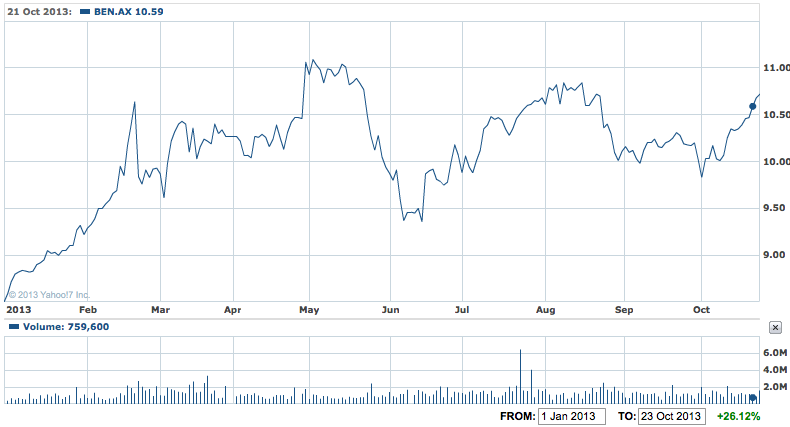Bendigo and Adelaide Bank (BEN) shares edged to a five year high yesterday as the company held its 2013 AGM and the shares of bigger competitors such as the Commonwealth, ANZ and Westpac hit all time highs.
Bendigo shares rose 11c to $11.19, the highest since late 2008, but well under the $17 level plus reached before the GFC.
While it was a welcome rise for Bendigo shareholders, there was a sense from the AGM that the management and board feel it is being left out of the boom, which seems to be flowing to the big four banks.
The bank’s CEO told shareholders the new Federal government should put the big banks’ dominance under a microscope as part of its mooted inquiry into the financial system, claiming the industry lacks a level playing field.
But at the same time the chairman also told the meeting that Bendigo had returned to funding markets for new debt and capital raisings, which must be a positive for the country’s 5th largest bank.
The regional lender’s managing director Mike Hirst told the meeting that in the last few years the bank had been fighting ‘‘with one hand tied behind our back” because a wave of new regulations which have favoured Bendigo’s bigger competitors.
He said the fixed costs of complying with new rules designed to make banks safer had been a bigger cost for smaller banks than for the large ones.
And he repeated criticism that the Rudd government’s guarantee on bank borrowing, for which banks with lower credit ratings had to pay a higher fee.
”That decision had a major impact on customer choice which is a point I want to emphasise. I think people often misconstrue the nature of the concentrated nature of Australia’s financial sector as being anti competitive,” Mr Hirst said at the AGM in Bendigo.
”I can assure you the market is very competitive. What we don’t have, however, is an even playing field that promotes customer choice. Size is a powerful ally in any endeavour. In banking in Australia it provides larger players with funding and regulatory advantages that ultimately restrict consumer choice. That needs to be put under a microscope.
"Low demand for credit makes it difficult to grow revenue whilst maintaining profitability. Additionally, the new regulatory changes arising from Basel III require higher capital to be held by banks and have driven increased costs of deposits.
"These imposts, combined with the lower level of absolute interest rates, will ensure lower returns from banks than those experienced in the years prior to the Global Financial Crisis.
"Current opportunities for meaningful growth are limited to acquisitions and gaining market share – the latter often as a result of silly pricing and I’m sure you’ve all seen that before.
"When the economy enters a low growth phase such as this, markets reward companies that drive bottom line improvement through cost cutting at both the operating and investment level. However, long term research on companies shows that the best performed firms are those that invest, innovate and grow through periods of difficulty – and that is what we plan to do," Mr Hirst said.
Mr Hirst conceded that many of the changes were warranted and even overdue, but said some of the regulatory change was ”a solution looking for a problem".
BEN YTD – Catches the banking surge, finally

But the banks’ chairman Robert Johanson told the meeting that the current tough times would continue for a while – he said the impact of the GFC had another "five years" to run and perhaps longer.
"The banking industry is experiencing very slow credit growth when compared to the strong growth during the decade leading up to the GFC. To a large extent this is driven by low levels of business and consumer confidence, which in turn leads to a desire to deleverage. It is entirely appropriate that both individuals and businesses seek to reduce debt levels in times of uncertainty.
"For example, more than one-in-three of our mortgage holders are making repayments faster than they are contractually required, and are accordingly ahead of their repayment schedule. This is impacting the net credit growth and is a drag on our key lending portfolios," the chairman told the meeting.
But there was also a positive from the meeting – that the bank had a high level of funding from deposits, and that it was completed raising capital for the new prudential rules.
"Our strong level of deposit funding, in the order of 80% of our overall funding mix, places us in an enviable position. However, it is important we continue to avail ourselves of a range of different funding options to ensure we can call on different funding sources if necessary.
"Recent improvements in the pricing of wholesale funding markets allowed us last week to issue $400m of three year term debt to institutional investors at a competitive price. This is the first time we have undertaken a deal of this nature since the merger in 2007.
"The strong demand for this offer, much of it from institutions in Asia who had never before participated in an issue by us, reflects the strength of our balance sheet and low risk business model in addition to the recent ratings upgrades from S&P and Fitch.
"Last week we also completed the issue of convertible preference shares and raised a total of approximately $270 million. With this, we are now compliant with the new capital requirements for banks under the Basle III rules," Mr Johanson told the meeting.
So while it is tough for banks of all sizes to grow rapidly, and smaller banks are discriminated against by some regulations, that hasn’t stopped Bendigo from funding itself and return to raising debt and capital from the financial markets – and in doing so, meeting the tough new rules on capital and liquidity.













